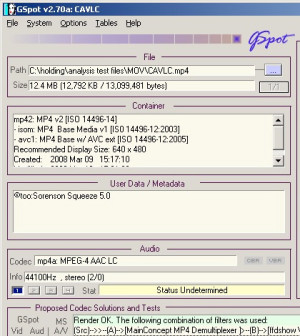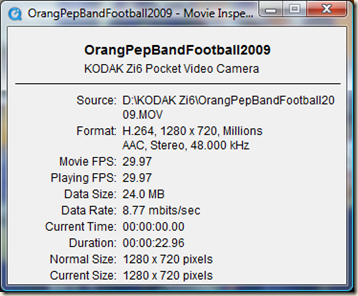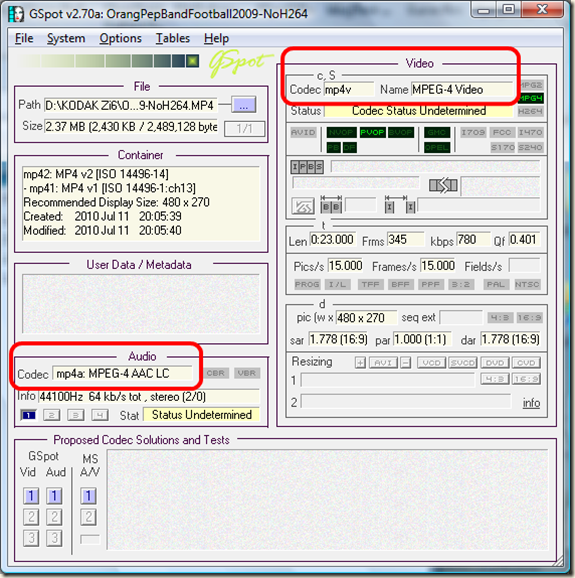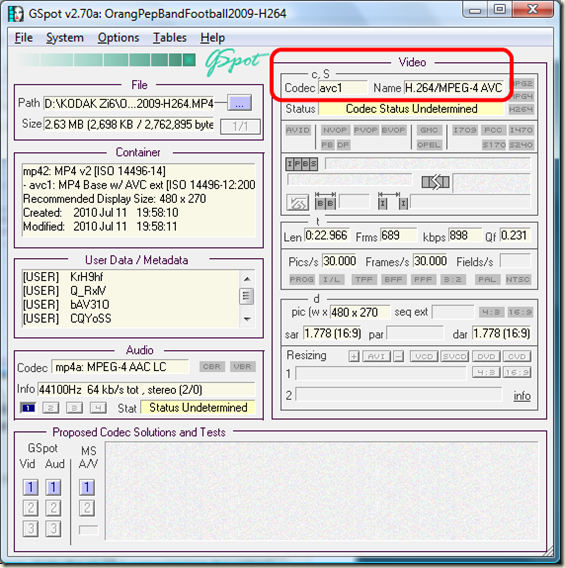TIP: Diagnose Problem Audio/Video with GSpot

If you have media files that are behaving badly on playback, you may want to use a program like GSpot to look into the file details. Occasionally, we hear from users who are creating and uploading MP4 files to Ensemble Video (without transcoding), and find that they play back in the Flash-based Flowplayer without either audio or video. A little frustrating, eh? While in rare instances there can be file corruption or other issues that can cause audio or video to become disabled on playback, the most common problem is an un-supported compression format. MP4 is a digital media container that can deliver different types of audio and video, and on some systems it is actually quite easy (sometimes inadvertently) to create a file that uses older audio or video compression formats that aren’t supported in a Flash-based player. Specifically, to be viewed in the Ensemble Video implementation of the Flash-based Flowplayer, an MP4 video would need to use AAC (Advanced Audio Coding)audio compression and H.264 video compression (which is sometimes referred to as MPEG-4 Part 10 or MPEG-4 Advanced Video Coding). You can check out the compression formats for MOV and MP4 files with QuickTime, of course, using the Movie Inspector window. Here are the attributes for the original MOV file I shot in the Carrier Dome.  If you’re on a Windows PC, there is a little-known program called GSpot of all things, that is useful for viewing the technical details of a wide range of video files. You can grab the latest version of GSpot as a FREE download at download.com. Here is a GSpot screen shot showing details on the video file in the embedded player above, an MP4 version of the original MOV file with reduced image dimensions and compressed for Internet streaming. Note that while the audio compression is AAC, the video compression is not the H.264 compression required for playback in the Flash-based Flowplayer. It is an earlier video compression technology called MPEG-4 Part 2which was implemented in QuickTime by Apple before the superior H.264 compression arrived on the scene.
If you’re on a Windows PC, there is a little-known program called GSpot of all things, that is useful for viewing the technical details of a wide range of video files. You can grab the latest version of GSpot as a FREE download at download.com. Here is a GSpot screen shot showing details on the video file in the embedded player above, an MP4 version of the original MOV file with reduced image dimensions and compressed for Internet streaming. Note that while the audio compression is AAC, the video compression is not the H.264 compression required for playback in the Flash-based Flowplayer. It is an earlier video compression technology called MPEG-4 Part 2which was implemented in QuickTime by Apple before the superior H.264 compression arrived on the scene.  One of the great things about GSpot is that you can use it to view details on Windows Media, QuickTime MOV, MP4, FLV, AVI, and other files as well. It shows bit rate for audio and video, audio and video codec (another term for compression), and it also provides frame rate, pixel dimensions, and file size. I created another version of the SU Orange Pep Band video with H.264 compression, just so you wouldn’t be left too frustrated. While the game left something to be desired, the band was great! [ensemblevideo contentid=kLeUW-fdlkyoXTd5Zj0Lag] The details of that video file, as reported by GSpot, are shown here (Note the H.264 Video compression!).
One of the great things about GSpot is that you can use it to view details on Windows Media, QuickTime MOV, MP4, FLV, AVI, and other files as well. It shows bit rate for audio and video, audio and video codec (another term for compression), and it also provides frame rate, pixel dimensions, and file size. I created another version of the SU Orange Pep Band video with H.264 compression, just so you wouldn’t be left too frustrated. While the game left something to be desired, the band was great! [ensemblevideo contentid=kLeUW-fdlkyoXTd5Zj0Lag] The details of that video file, as reported by GSpot, are shown here (Note the H.264 Video compression!).  If you work with a variety of media –which is very often the case in the large, diverse organizations that use Ensemble Video– GSpot can be a very valuable tool! Summary GSPot is a useful program that can help you diagnose playback, quality, and compatibility issues with a wide range of audio/video media files.
If you work with a variety of media –which is very often the case in the large, diverse organizations that use Ensemble Video– GSpot can be a very valuable tool! Summary GSPot is a useful program that can help you diagnose playback, quality, and compatibility issues with a wide range of audio/video media files.













You must be logged in to post a comment Login